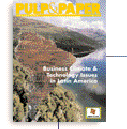
Focus on “the fix”
We broke it, and we can fix it.” That’s what Georgia-Pacific chairman, CEO, and president A.D. “Pete” Correll told a trade industry group in Boston last year after he related that the entire equity value of all U.S. publicly traded forest products companies was, at that time, worth less than half of the equity value of U.S. beverage giant Coca-Cola.
“We didn’t start out that way. We let it happen. We broke it, and we can fix it,” Correll said. He suggested that containerboard and corrugated containers should not solely be considered as commodity grades “in a high-stakes game” with volatile pricing, but sold as a “unique packaging asset” that truly has no major competition in the world. “We have a long way to go in my company, and I’d bet you have a long way to go in your business.”
But containerboard and corrugated containers isn’t the only market sector to which this applies. Almost every grade of pulp, paper, and paperboard is in dire need of some innovative re-thinking and some strong marketing prowess. But the processes and people that make these products need innovation, too.
WHERE TO BEGIN. The need for a “fix” has initially created some confusion, with many companies looking only at the organization (e.g., consolidation, restructuring, downsizing, rightsizing, etc.) as the problem. That’s easy to do when management consultants tell you to diversify during one decade and focus in the next one.
But the real excitement of fixing the problem—and the part that might actually create opportunities for both producers and suppliers—will come from the spirit of innovation that is only beginning to be shown.
Where does your company stand on innovating the processes that make the products? Since R&D by paper and converting companies has become only a ghost of what it once was, it may be up to suppliers of equipment and chemicals to lead this charge. But even they have begun to renounce their responsibility, simply stating that paper companies aren’t willing to pay what it takes to buy innovation. And it’s true.
A box doesn’t just have to be a box. Uncoated free-sheet doesn’t just have to be uncoated free-sheet. And the cellulose-intensive process of making paper doesn’t necessarily have to be the process of the future. Composite products may be the way of the future, but can the industry’s current equipment options handle a wide mix of materials?
The trick here is to get companies to realize that changes are needed across the board and get them to attempt “the fix”—in their manufacturing processes, their management offices, and their marketing departments.
THE PEOPLE FACTOR. But processes don’t work without people, especially processes for company-wide change. How many times have you heard this line from a CEO, human resources director, manager, etc.: “Our people are our greatest asset?” But try asking yourself this question: “What assets do my company’s greatest people have?”
Does the company have employees who can look at the process and products from an innovative perspective, and does the company create an atmosphere to promote such thinking? Can new ideas—not just product related ones—be carried forward by the whole organization, or is it only up to the idea generator to make everything happen all the way to the corporate suite? If that’s the case, then such a person is probably going to walk out the door with that idea.
But are employees motivated on their own to seek and suggest solutions? Or are they simply motivated by the time clock, the vacation package, the protection of their salary and benefits. It’s no wonder that today’s mega-corporations are risk-averse. Most of the employees are risk-averse as well. The burden of “the fix” can’t lie wholly on management’s shoulders when employees aren’t willing to step forward and make a difference.
As with all efforts at futuristic thinking, not every idea will turn out to be the right one. Noted psychic Jeanne Dixon didn’t hit 100% on all her predictions. And in 1985, Coca-Cola introduced the fiasco that was New Coke. But someone has to push the envelope.
The important message is that “the fix” that Mr. Correll and others in the industry talk about requires new and better thinking from all of us. We broke it, and we can fix it.

|




